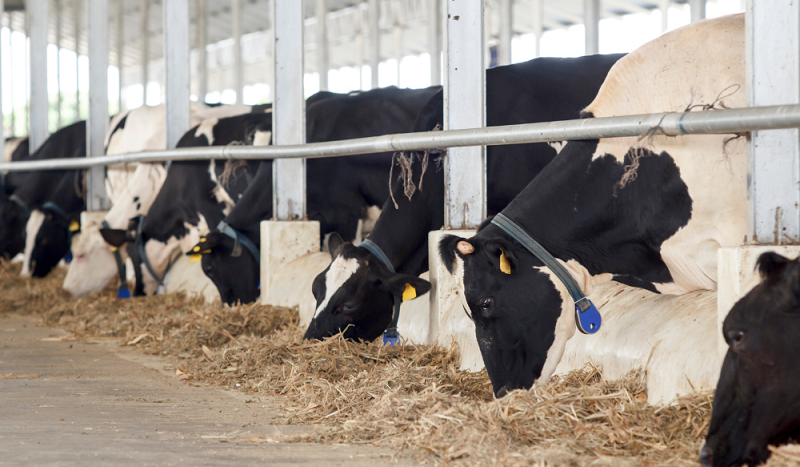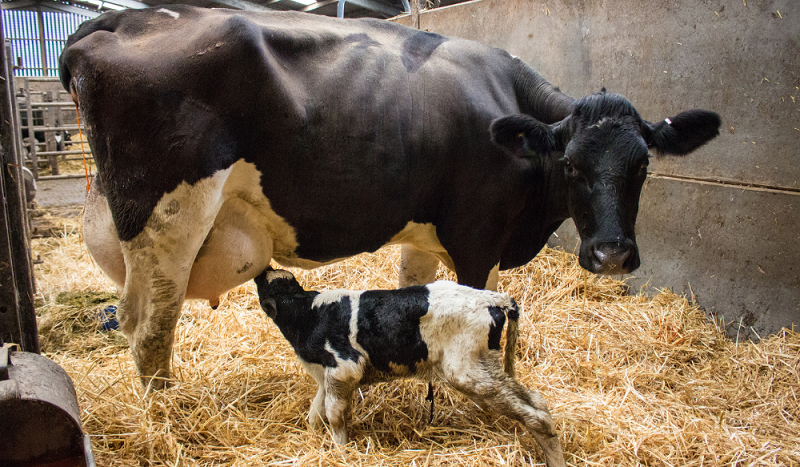Four ways to breed your dairy cows to cut feed bills
Tuesday, 1 August 2023
Breeding may not be the obvious way to cut feed bills. However, evidence shows the difference in feed consumption between the genetically best and worst converters of feed into milk can be as much as 400 kg per lactation. Here’s how you can use genetics to cut feed bills.
Soaring costs of milk production and squeezed margins are causing many dairy producers to turn their attention to cutting their input costs. And with feed representing the largest variable cost, the feed bill is a substantial and obvious target.
The immediate way to cut this may be through the better buying of ingredients; improving feeding and forage management; reducing feed-rates; or introducing home-grown concentrate feeds.
But what about breeding? This may not be the first choice, but there’s increasing evidence to indicate that an animal’s genetics can have a profound influence on the amount of feed it needs to produce each litre of milk.
Over many decades, breeding has proven to be the cheapest and most effective way to make permanent, long-term improvements to a wide cross-section of traits. Considering this, it becomes clear that including genetic indexes which affect feed efficiency should be part of every herd’s breeding strategy.
1. Feed Advantage (FAdv)
At the top of the list is Feed Advantage. This genetic index was introduced by AHDB around two years ago and formulated to help producers breed animals which use the least amount of feed for their production needs.
This index accounts for the feed an animal is expected to eat given her solids-corrected milk production and the feed she needs for her maintenance.
It then compares this with her actual feed consumption and, in so doing, it identifies animals which have demonstrated they are efficient converters.
Professor Mike Coffey, who heads the animal breeding team at SRUC, explains:
“The actual feed consumption used in the calculation of this index is not measured at the herd level, as commercial milk producers don’t usually have the equipment to record precise dry matter intakes on an individual cow basis.
“However, the UK is fortunate to have the world’s longest-running trial in dairy genetic selection at the SRUC Crichton Royal Farm in Scotland, where every animal in the Langhill herd has its daily feed intake recorded through its productive life, and its liveweight and body condition score recorded every week.”
This project, which has been running for around 40 years, has provided a wealth of information on animal performance, genetics and specifically genotype.
“It’s enabled us to translate an animal’s DNA into meaningful genomic indexes farmers can use – in this case, the Feed Advantage,” he says, emphasising the importance of both the quantity and independence of the data, and the calculation of the index against a UK genomic background.
“By using this index as part of their selection criteria, farmers can expect to gradually improve the feed conversion efficiency of their cows on a permanent basis, and pass these improvements on to the next generation,” he says.
The scale of the benefits may be surprising to producers. Professor Coffey continues:
“The evidence indicates that the most efficient cows consume as much as 400 kg less feed [dry matter] in just one lactation than the least efficient cows, given the same level of production. The scope for this to reduce feed bills does not need spelling out, and greenhouse gas emissions will obviously also decline as a result.”
But only Holsteins (male and female) which have a genomic index calculated will receive an index for Feed Advantage; for other dairy breeds and non-genotyped animals, producers will need to look elsewhere.

2. Maintenance (Maint)
Maintenance is the next best genetic index for breeders to use, where they don’t have access to Feed Advantage.
This is the case for all non-Holstein dairy breeds. Marco Winters, Head of Animal Genetics at AHDB says:
“Its calculation considers the weight of the cow, a figure that’s based on proxy traits including stature, chest width, body depth and angularity,
“These are used in lieu of actual cow weights, as many producers don’t routinely weigh their dairy cattle in the UK. However, we’d urge them to do so, allowing us eventually to create a database of weights to include in the calculation of this index.”
The logic to this index is that the cost of maintaining a cow is related to its weight: a cow weighing 600 kg will have a lower feed requirement for its maintenance than a cow which weighs 700 kg, even if they give the same amount of milk.
Figures for Maintenance Index are expressed on a scale of roughly +50 kg to -50 kg, giving an indication of the average difference in weight expected in a bull’s daughters.
Negative figures are desirable as they will help producers breed cattle with lower feed costs, all else being equal.
3. Lifespan (LS)
The Lifespan Index also plays a role in reducing feed use, largely because of its favourable impact on replacement rate which cuts heifer rearing costs. Since these costs account for about 20% of all milk production costs, much accounted for by feed, there’s clearly scope to use far less if fewer heifers need to be reared.
The LS Index gives a prediction of involuntary culling and, where available, it is calculated from actual cow survival.
Expressed as extra days of life on a scale of roughly -305 to +305, daughters of a +305 Lifespan Index bull are predicted to live, on average, 305 days longer than daughters of a sire whose index is zero.
As with all UK genetic indexes, zero represents the breed average for females.

4. EnviroCow
Although the formulation used for EnviroCow is designed to minimise greenhouse gas (GHG) emissions per litre of milk, most of this reduction is achieved through improving feed conversion efficiency.
Analysis has shown that each point of EnviroCow can cut feed intake by as much as 10% throughout a cow’s lifetime, while increasing lifetime production by 33%.
Longer lifespans, improved fertility and productivity are all built into this index and also play their part.
Other traits
Although we’ve highlighted the top four genetic indexes to help cut feed use, many other traits will also be influential.
Genetic indexes for all fertility and health traits – such as mastitis and lameness – and anything potentially influencing involuntary culling, will all contribute.
A final observation is offered by Marco Winters, who says that despite their importance, the indexes cited should not be used alone, but as part of a balanced breeding plan:
“Our advice is to use the overall profitability index which suits your farming system for your primary selection, whether that’s Profitable Lifetime Index [£PLI] for year-round calving herds, or Spring or Autumn Calving Indexes [£SCI or £ACI] for block calving herds respectively,
“These are the indexes which have been formulated to breed cattle with the most profitable genetics for UK management and trading conditions, but it’s always worth keeping an eye on the traits listed above to improve the efficiency and lower the feed bill over the long term for your herd.”
Read more about dairy breeding and genetics


